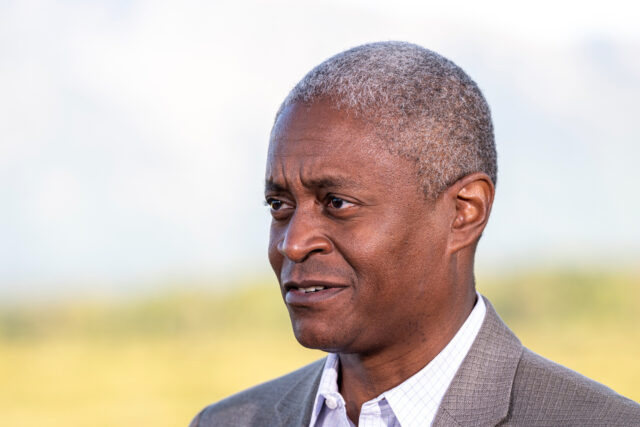Atlanta Federal Reserve President Raphael Bostic said Wednesday that he does not think the Fed will start cutting until November or December.
“If the economy evolves as I expect, and that’s going to be seeing continued robustness in GDP, unemployment, and a slow decline of inflation through the course of the year, I think it would be appropriate for us to do start moving down at the end of this year, the fourth quarter,” Bostic said in an interview on CNBC’s “Squawk Box” program. “We’ll just have to see where the data come in.”
Bostic is a voting members of the Federal Open Market Committee, the unit of the Fed that sets interest rate policy. At the March meeting, two Fed officials indicated that they expected only a single cut this year and two said they expected no cuts. Bostic’s remarks indicate that he is likely among those four.
The media view of Fed officials is that the Fed will cut rates three times this year. That would require the Fed to cut by September at the latest, followed by cuts at the November and December meeting. There is no meeting in October.
Bostic noted that progress on bringing down inflation has stalled in recent months. Monthly inflation rose at an annualized rate of 4.2 percent in January and 4.1 percent in February.
“The road is going to be bumpy, and I think if you’ve looked over the last several months, inflation hasn’t moved very much relative to where we were at the end of 2023,” he said. “There are some secondary measures in the inflation numbers that have gotten me a bit concerned that things may move even slower.”
The Atlanta Fed calculates what it calls “sticky price” inflation, the price changes of goods and services whose prices do not change very much. In February, sticky inflation was up 4.4 percent from a year ago. The three-month annualized sticky-price inflation rate, which some economists think is a better indicator of inflation trends, was up 5.0 percent, the highest since April of 2023.
Bostic noted that goods prices, which were a disinflationary force for most of last year, are now adding to inflation in many cases. He pointed out that a high proportion good components are up at a more than three percent rate and some up more than 5 percent.
“Those are much higher now than they were before and they’re starting to trend back to what we saw in the high inflation period,” Bostic added. “They’re moving away from what we’d like to see. So I’ve got to make sure that those aren’t hiding some extra upward pressure and pricing pressure before I’m going to want to move our policy rate.”
Bostic indicated that he had changed his expectations on inflation and rates as new data about the economy has come in. He now thinks inflation is going to decline “much slower than what many have expected.”

COMMENTS
Please let us know if you're having issues with commenting.